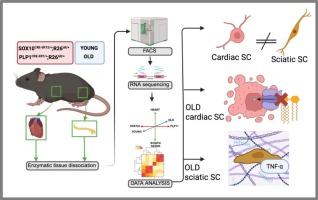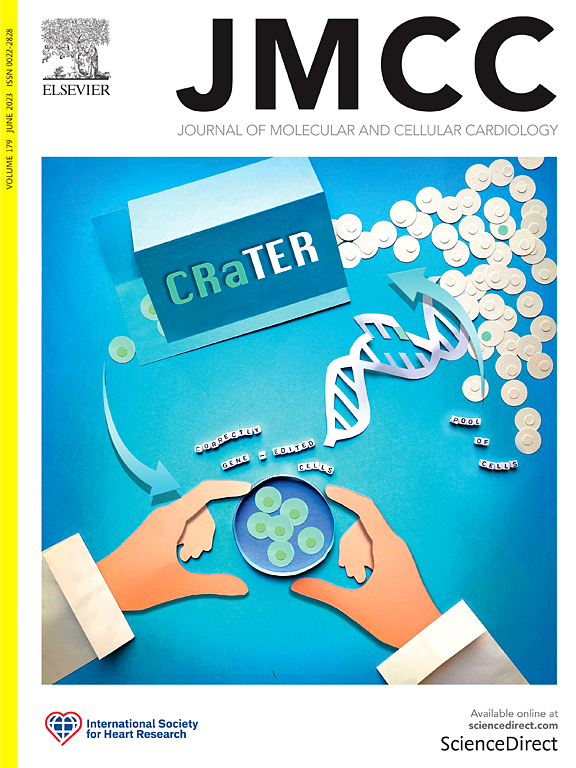Multi-level expression profiling of cardiac and musculoskeletal Schwann cells in young and old mice
IF 4.7
2区 医学
Q1 CARDIAC & CARDIOVASCULAR SYSTEMS
引用次数: 0
Abstract
Schwann cells (SC) are crucial for physiological impulse conduction in peripheral nerves. They produce myelin, provide axonal metabolic support, and contribute to reparatory processes after nerve injury. During aging, peripheral nerves acquire myelin structural anomalies and are characterized by a lower fraction of SC and a higher fraction of senescent cells. All these changes correlate with impaired electrical conduction and consequently altered function of target tissues including skeletal muscle weakness and cardiac arrhythmia. To characterize and compare cardiac and sciatic nerve SC, as well as to explore age-related differences in SC abundance and their properties, we analyzed two TdTomato reporter mouse strains to isolate Sox10 or Plp1 expressing SC. We performed RNA-sequencing on sorted TdTomato-positive cells from the heart and sciatic nerve and validated transcriptomic findings at the protein level using immunofluorescence. Our data reveal a pro-angiogenic profile in cardiac SC when compared to sciatic SC. In addition, higher levels of neural-death associated genes and lower gene and protein expression levels of the fatty acid co-transporter Fabp4/FABP4 are detected in cardiac SC from old compared to young mice, suggesting an aging-related impairment of fatty acid transport. Finally, sciatic SC activate collagen remodeling and increased pro-inflammatory signaling including TNFα. Thus, cardiac and musculoskeletal SC have different expression profiles, and undergo different changes during aging, which may contribute to impaired nerve function in both organ systems.

年轻和年老小鼠心脏和肌肉骨骼雪旺细胞的多层次表达谱。
雪旺细胞在周围神经的生理冲动传导中起着至关重要的作用。它们产生髓磷脂,提供轴突代谢支持,并参与神经损伤后的修复过程。在衰老过程中,周围神经获得髓鞘结构异常,其特征是SC的比例较低,衰老细胞的比例较高。所有这些变化都与电传导受损相关,从而改变靶组织的功能,包括骨骼肌无力和心律失常。为了表征和比较心脏和坐骨神经SC,以及探索SC丰度的年龄相关差异及其特性,我们分析了两种TdTomato报告小鼠菌株,分离出表达Sox10或Plp1的SC。我们对从心脏和坐骨神经中分离出来的TdTomato阳性细胞进行了rna测序,并在蛋白水平上使用免疫荧光验证转录组学结果。我们的数据显示,与坐骨SC相比,心脏SC中有促血管生成的特征。此外,与年轻小鼠相比,老年小鼠的心脏SC中检测到较高水平的神经死亡相关基因和较低水平的脂肪酸共转运蛋白Fabp4/ Fabp4的基因和蛋白表达,这表明衰老相关的脂肪酸转运损伤。最后,坐骨SC激活胶原重塑,增加促炎信号,包括TNFα。因此,心脏和肌肉骨骼SC具有不同的表达谱,并在衰老过程中经历不同的变化,这可能导致两个器官系统的神经功能受损。
本文章由计算机程序翻译,如有差异,请以英文原文为准。
求助全文
约1分钟内获得全文
求助全文
来源期刊
CiteScore
10.70
自引率
0.00%
发文量
171
审稿时长
42 days
期刊介绍:
The Journal of Molecular and Cellular Cardiology publishes work advancing knowledge of the mechanisms responsible for both normal and diseased cardiovascular function. To this end papers are published in all relevant areas. These include (but are not limited to): structural biology; genetics; proteomics; morphology; stem cells; molecular biology; metabolism; biophysics; bioengineering; computational modeling and systems analysis; electrophysiology; pharmacology and physiology. Papers are encouraged with both basic and translational approaches. The journal is directed not only to basic scientists but also to clinical cardiologists who wish to follow the rapidly advancing frontiers of basic knowledge of the heart and circulation.

 求助内容:
求助内容: 应助结果提醒方式:
应助结果提醒方式:


